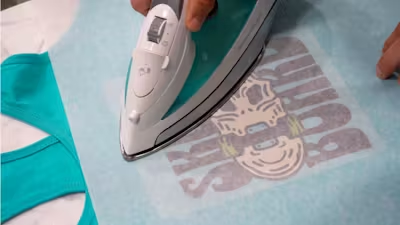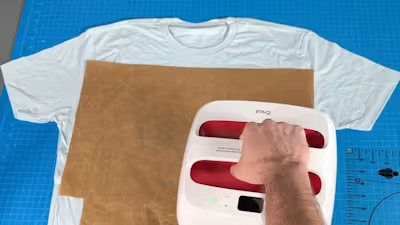Pressing DTF transfers with an iron or handheld heat press requires accurate temperature control. Too cool, and your transfer won't stick properly. Too hot, and you risk scorching your garment. But household irons have varied settings, and handheld presses like Cricut typically offer just three heat levels-so how do you know if you're hitting the right temperature?
This matters whether you're crafting at home or running a small business. Even users with tabletop heat presses, which display specific temperatures, can benefit from verifying their actual operating temperature. Getting it right prevents incomplete transfers that require repressing and protects your garments from heat damage. In this guide, we show you two simple methods to test your device's temperature and share tips for achieving consistent results. Let's jump right into it.

How to check the temperature: The short answer
There are two easy ways to verify your heat press temperature: temperature test strips or an infrared thermometer. Both tools are affordable (around $20-30) and help ensure your device hits the mark. Here's how to use each option and choose the right one for your needs.
Temperature test strips
Temperature test strips serve as disposable thermometers. Originally designed for screen printing, they are equally effective for heat pressing. These small strips feature temperature-sensitive squares that turn black when they reach specific heat levels.
The strips come in packs of 16 and cost around $25. We recommend the Paper Thermometer brand, which offers clear temperature indicators and reliable results. Each strip displays five temperature readings from 290°F to 330°F, making them perfect for dialing in the optimal 310°F needed for DTF transfers. These US-made strips are stored easily in any workspace and maintain accuracy when kept in a cool, dry place.
Pros and cons: Test strips offer slightly better accuracy than infrared thermometers because you can simulate actual pressing conditions. However, each strip can only be used once, so you'll need to stock up if you test temperatures frequently.

Using temperature strips to test an iron:
- Start your iron on its "high" setting (typically 4+) and let it heat up for 5 minutes.
- Place a test fabric (like a t-shirt) on your heat-resistant pressing surface and press for 10-15 seconds to warm it up.
- Place a single temperature strip on a sheet of paper and face-down on your test fabric. Never press the iron directly onto the strip.
- Press down with the iron on top of the paper for 15 seconds.
- Check which square turned the darkest black. If you haven't hit 310°F, increase the iron setting and test again. If you've gone over, decrease and retest.
- Once you find the right setting, mark it with tape or a permanent marker on your iron's dial. You may need several strips to zero in on the perfect setting.
Using temperature strips to test a handheld heat press:
- Handheld presses like the Cricut typically offer three heat settings, with "medium" designed to hit 300-350°F. Testing verifies your device operates correctly.
- Place a test fabric on your pressing surface and warm it up with a 15-second press.
- Position a temperature strip on paper and place it face-down on your test fabric.
- Press for 15 seconds using your medium setting.
- Check the strip results. If you haven't reached 310°F, test the high setting. If you're running too hot, try the low setting.
- Write down which setting works best for DTF transfers on your specific device.
Using temperature strips to test a tabletop heat press:
- While tabletop presses display specific temperatures, cheaper models may read incorrectly or heat unevenly across the platen. Test with 5 strips to check both accuracy and heat distribution.
- Place temperature strips on 5 separate pieces of paper and warm up your test fabric with a 15-second press.
- Position the papers with strips face-down in all four corners (not at the edges) and the center of your test fabric. The paper can overlap slightly.
- Press for 15 seconds at your target temperature (310°F for DTF).
- Check all five strips - they should show consistent readings. Variations indicate uneven heating or inaccurate temperature settings.
- If your digital display doesn't match the strip readings, adjust your temperature setting to a higher or lower temperature to compensate. Major inconsistencies across the platen may signal it's time for a new heat press machine.
Infrared thermometer
An infrared thermometer provides instant temperature readings without contact. These handheld "gun-style" devices project a laser point to help you aim at specific spots on your heat press surface. Simply pull the trigger to get a quick digital readout of the surface temperature, making them a popular tool for both heat pressing and general household tasks like cooking or auto maintenance.
Most infrared thermometers suitable for heat pressing cost between $20 and $35. Look for models that measure up to at least 400°F and feature a backlit display for easy reading. These tools typically run on AAA batteries and come ready to use right out of the box. Here is one high-rated example.
Pros and cons: Compared to temperature strips, infrared thermometers offer speed and convenience. You can take unlimited readings without using up supplies, making them great for frequent testing. However, they may provide slightly less accurate results than test strips because they measure surface temperature rather than simulate actual heat transfer conditions.

Using an infrared thermometer to test an iron or handheld heat press:
- Point the infrared thermometer at your heated iron or press surface from about 14 inches away for an instant temperature reading.
- For a more practical test, press a piece of paper on your test fabric for 15 seconds, then immediately check the temperature of the pressed area.
- The actual operating temperature likely falls between your direct surface reading and the pressed paper reading. Test both to understand your temperature range.
- The thermometer's quick response lets you rapidly test different heat settings until you find the right one. Mark or note this setting for future use.
- When testing handheld presses, check each heat level to confirm which setting best achieves your target temperature of 310°F.
Using an infrared thermometer to test a tabletop heat press:
- Set your press to 310°F and let it fully heat up. Position the thermometer about 14 inches from the surface.
- Take readings from five points on the upper platen: all four corners and the center. This reveals both temperature accuracy and heating consistency.
- For an alternative test, press a large piece of parchment paper or protective guard sheet, then immediately check those same five points.
- You might need multiple presses for all test points since heat dissipates quickly from the paper. Work systematically to get accurate readings.
- Compare your thermometer readings to the press's digital display. Note any difference so you can adjust your temperature settings accordingly.
Temperature tips for home iron or handheld heat press
- Getting your temperature right the first time will prevent multiple pressings and ensure durable prints. Aim for 310°F, but remember-it's better to run slightly hot than too cool.
- Too low a temperature can cause incomplete transfers. If parts of your design aren't sticking, check your temperature before assuming it's a pressure problem.
- Always use a protective guard sheet or parchment paper between your heating element and fabric. This prevents scorching, especially on delicate materials.
- When pressing near buttons, zippers, seams, or pockets, use heat press pillows to create an even surface and maintain consistent pressure.
- Silicone application pads help protect your garments and distribute heat evenly, but remember to increase both your temperature and pressure to compensate for the extra layer.
- Test your temperature periodically, especially when switching between different types of garments or if you notice changes in your transfer results.

Pressing perfect DTF transfers: Temperature matters
Your success with DTF transfers depends on maintaining the right temperature. Whether you choose temperature test strips for their precision or an infrared thermometer for their reusability, regular testing helps you dial in your settings and achieve consistent results.
Make sure to read our tutorials on using a home iron and applying DTF transfers with a Cricut. Take time to test and mark your ideal settings. This small investment in preparation prevents wasted materials and ensures professional-quality transfers every time.
When you're ready to start printing, trust Ninja Transfers for high-quality DTF transfers and essential supplies. For one-stop shopping, Ninja Blanks carries high-quality blank apparel that's perfect for heat pressing. With the right temperature and a little practice, you'll be creating professional-quality custom apparel from your first press to your hundredth.








































